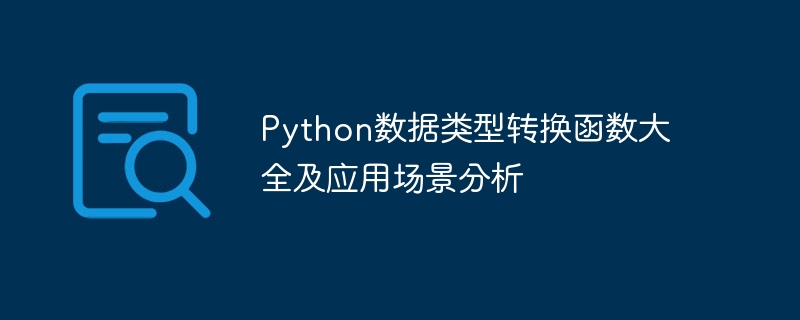Home >Backend Development >Python Tutorial >Comprehensive analysis of Python's data type conversion functions and their applicable scenarios
Comprehensive analysis of Python's data type conversion functions and their applicable scenarios
- 王林Original
- 2024-01-20 10:40:06891browse

Comprehensive collection of Python data type conversion functions and application scenario analysis
[Introduction]
Data type conversion is a very common operation in programming, especially when processing When users enter data, data is stored and analyzed. As a dynamically typed language, Python provides a wealth of data type conversion functions to meet different needs. This article will introduce commonly used data type conversion functions in Python, list some common application scenarios, and give specific code examples.
[1. Integer conversion]
- int(x): Convert parameter x to an integer. If x is a string, you can specify the base (default is decimal).
- bin(x): Convert the integer x to a binary string.
Application scenario:
- The data input by the user may be in the form of a string and needs to be converted into an integer for calculation.
- Perform binary number related operations, such as bit operations, processing network data, etc.
Code example:
# 整数转换 x = "10" y = int(x) print(y) # 输出:10 # 进制转换 num = 10 binary_str = bin(num) print(binary_str) # 输出:0b1010
[2. Floating point number conversion]
- float(x): Convert parameter x to a floating point number.
- round(x[, n]): Round the floating point number x, and you can specify n to retain the number of decimal places (default is 0).
Application scenarios:
- Convert floating-point numbers in string form to floating-point number types for calculation.
- Control the precision of floating point numbers and perform rounding operations.
Code example:
# 浮点数转换 x = "3.14" y = float(x) print(y) # 输出:3.14 # 浮点数舍入 num = 3.14159 rounded_num = round(num, 2) print(rounded_num) # 输出:3.14
[3. String conversion]
- str(x): Convert object x into string form.
- chr(x): Convert the integer x to the corresponding ASCII character.
Application scenarios:
- Convert other data types to string types to facilitate output, splicing and other operations.
- Convert ASCII code.
Code example:
# 对象转字符串 x = 100 y = str(x) print(y) # 输出:"100" # ASCII转换 asc_val = 65 char = chr(asc_val) print(char) # 输出:"A"
[4. List, tuple and set conversion]
- list(x): Convert the iterable object x for a list.
- tuple(x): Convert the iterable object x into a tuple.
- set(x): Convert the iterable object x to a set.
Application scenarios:
- Convert other iterable objects into lists, tuples or sets for related operations.
- Data deduplication, fast search and other needs.
Code example:
# 可迭代对象转列表
x = (1, 2, 3)
y = list(x)
print(y) # 输出:[1, 2, 3]
# 可迭代对象转元组
x = [1, 2, 3]
y = tuple(x)
print(y) # 输出:(1, 2, 3)
# 可迭代对象转集合
x = [1, 1, 2, 2, 3, 3]
y = set(x)
print(y) # 输出:{1, 2, 3}[5. Dictionary conversion]
- dict(x): Convert the iterable object x into a dictionary, requirements The x elements must be an iterable object and a tuple of length 2.
Application scenario:
- Convert an iterable object containing key-value pairs into a dictionary.
- Merge or update dictionary data.
Code examples:
# 可迭代对象转字典
x = [("name", "Alice"), ("age", 20)]
y = dict(x)
print(y) # 输出:{"name": "Alice", "age": 20}[Conclusion]
This article introduces the commonly used data type conversion functions in Python, and gives specific application scenarios and code examples. In actual programming, rational use of data type conversion functions can improve the flexibility and readability of the code, while reducing potential problems caused by type errors. I hope this article can help readers in Python development.
The above is the detailed content of Comprehensive analysis of Python's data type conversion functions and their applicable scenarios. For more information, please follow other related articles on the PHP Chinese website!

